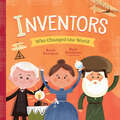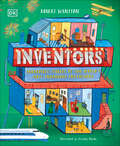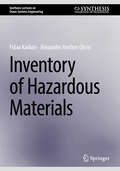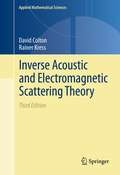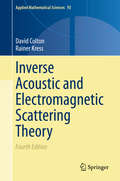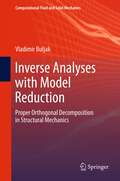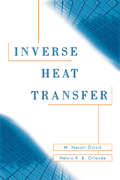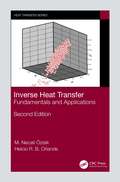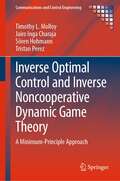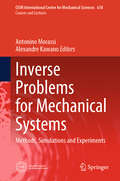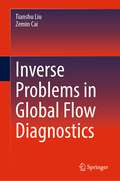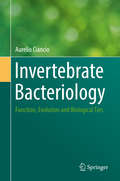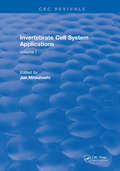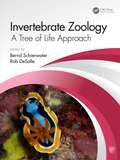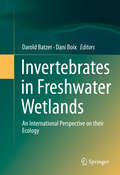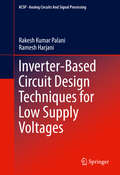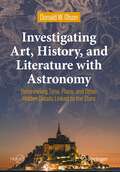- Table View
- List View
Inventors Who Changed the World (People Who Changed the World)
by Heidi PoelmanFrom the ranging curiosity of Leonardo da Vinci to the dedication and sacrifice of Marie Curie, Inventors Who Changed the World is a young child's first introduction to the brilliant people who taught us the meaning of perseverance and innovation. Simple text and adorable illustrations tell the contributions of nine renowned inventors from around the world: Cai Lun, Leonardo da Vinci, Marie Curie, Thomas Edison, Orville and Wilbur Wright, Grace Hopper, Johannes Gutenberg, and Louis Pasteur. Inspire your own little inventor with the words of these inventive heroes who changed the world.
Inventors: Incredible stories of the world's most ingenious inventions (DK Explorers)
by Robert WinstonMeet the masterminds behind the greatest inventions in history with this nonfiction book for kids aged 7 to 9.Step into Leonardo da Vinci's workshop, relax on board Hideo Shima's speedy bullet train, and join movie star Hedy Lamarr to bounce ideas around in between takes. Inventors looks at the towering achievements of more than 50 inventors in great detail. The stories are as unusual as they are unique. From Mr. Kellogg, who accidentally created cornflakes after leaving grains boiling for too long, to the ancient Turkish polymath Ismail al-Jazari, who decided the best way to power a clock was with a model elephant, to Sarah E. Goode's fold-up bed space-saving solution–the inventors of this book have all used tons of creativity to find ways to improve our world. These groundbreaking inventions include the very earliest discoveries to modern-day breakthroughs in science, food, transportation, technology, toys, and more.Each page is packed with jaw-dropping facts, with every inventors' achievements written as a story. Beautiful illustrations by Jessamy Hawke bring the inventor's stories to life, and fantastic photography highlights the detail of their designs. With incredible hand-painted cross-sections revealing the intricacies of a robotic arm, the first plane, and the printing press, young readers will marvel at being able to see close-up how these amazing machines work. The inventors come from all walks of life and parts of the world, making this the perfect book for every budding inventor.
Inventory of Biodiversity Today: New Methods and Discoveries
by Violaine NicolasOur knowledge of living organisms is still very limited, with less than 20% of the world’s species known to date. It is therefore essential to increase our efforts to inventory biodiversity. This is the goal of scientific research, but it is also a vital responsibility in the face of the sixth extinction. With so many species set to disappear before they can be analyzed, the compilation of this inventory now represents a major challenge. Thanks to the collaborative work of numerous researchers from the Institut de systématique, évolution, biodiversité (ISYEB) and other institutions, Inventory of Biodiversity Today presents the latest methods of field data collection and analysis. Strategies have diversified and are providing new and ever-more-precise data on a growing number of specimens. All of these data are integrated to delimit and describe living species, and are accessible to as many people as possible, so we can all take action on a daily basis to better understand and preserve our planet.
Inventory of Hazardous Materials (Synthesis Lectures on Ocean Systems Engineering)
by Alexander Arnfinn Olsen Fidaa KarkoriThis book provides a comprehensive guide to the Inventory of Hazardous Materials (IHM), a critical document for ensuring the safe and environmentally sound recycling of ships. At the heart of this book is the matter of compliance with the Hong Kong International Convention for the Safe and Environmentally Sound Recycling of Ships, which mandates the development and maintenance of an IHM throughout a vessel's lifecycle.The chapters cover topics such as the development, review, and verification of the initial Inventory for new construction vessels, as well as the maintenance and verification processes for vessels in service. Readers will find contributions by renowned experts in marine quality welding, non-destructive testing, radiographic inspection, ultrasonic inspection, and phased array inspection. The authors provide an expert analysis of these techniques through practical case studies and theoretical perspectives.This book is an essential resource for offshore installation managers, senior safety management professionals, academics, and students in industrial design and engineering. It offers invaluable insights into regulatory compliance and best practices in ship recycling. Whether you are a seasoned professional or a student entering the field, this guide will equip you with the knowledge needed to navigate the complexities of hazardous materials management in maritime contexts.
Inverse Acoustic and Electromagnetic Scattering Theory
by Rainer Kress David ColtonThe inverse scattering problem is central to many areas of science and technology such as radar and sonar, medical imaging, geophysical exploration and nondestructive testing. This book is devoted to the mathematical and numerical analysis of the inverse scattering problem for acoustic and electromagnetic waves. In this third edition, new sections have been added on the linear sampling and factorization methods for solving the inverse scattering problem as well as expanded treatments of iteration methods and uniqueness theorems for the inverse obstacle problem. These additions have in turn required an expanded presentation of both transmission eigenvalues and boundary integral equations in Sobolev spaces. As in the previous editions, emphasis has been given to simplicity over generality thus providing the reader with an accessible introduction to the field of inverse scattering theory. Review of earlier editions: "Colton and Kress have written a scholarly, state of the art account of their view of direct and inverse scattering. The book is a pleasure to read as a graduate text or to dip into at leisure. It suggests a number of open problems and will be a source of inspiration for many years to come." SIAM Review, September 1994 "This book should be on the desk of any researcher, any student, any teacher interested in scattering theory." Mathematical Intelligencer, June 1994
Inverse Acoustic and Electromagnetic Scattering Theory (Applied Mathematical Sciences #93)
by Rainer Kress David ColtonThe inverse scattering problem is central to many areas of science and technology such as radar, sonar, medical imaging, geophysical exploration and nondestructive testing. This book is devoted to the mathematical and numerical analysis of the inverse scattering problem for acoustic and electromagnetic waves. In this fourth edition, a number of significant additions have been made including a new chapter on transmission eigenvalues and a new section on the impedance boundary condition where particular attention has been made to the generalized impedance boundary condition and to nonlocal impedance boundary conditions. Brief discussions on the generalized linear sampling method, the method of recursive linearization, anisotropic media and the use of target signatures in inverse scattering theory have also been added.
Inverse Analyses with Model Reduction
by Vladimir BuljakIn this self-consistent monograph, the author gathers and describes different mathematical techniques and combines all together to form practical procedures for the inverse analyses. It puts together topics coming from mathematical programming, with soft computing and Proper Orthogonal Decomposition, in order to show, in the context of structural analyses, how the things work and what are the main problems one needs to tackle. Throughout the book a number of examples and exercises are worked out in order to make reader practically familiar with discussed topics.
Inverse Heat Conduction: Ill-Posed Problems
by James V. Beck Hamidreza Najafi Keith A. Woodbury Filippo de MonteInverse Heat Conduction A comprehensive reference on the field of inverse heat conduction problems (IHCPs), now including advanced topics, numerous practical examples, and downloadable MATLAB codes. The First Edition of the classic book Inverse Heat Conduction: III-Posed Problems, published in 1985, has been used as one of the primary references for researchers and professionals working on IHCPs due to its comprehensive scope and dedication to the topic. The Second Edition of the book is a largely revised version of the First Edition with several all-new chapters and significant enhancement of the previous material. Over the past 30 years, the authors of this Second Edition have collaborated on research projects that form the basis for this book, which can serve as an effective textbook for graduate students and as a reliable reference book for professionals. Examples and problems throughout the text reinforce concepts presented. The Second Edition continues emphasis from the First Edition on linear heat conduction problems with revised presentation of Stolz, Function Specification, and Tikhonov Regularization methods, and expands coverage to include Conjugate Gradient Methods and the Singular Value Decomposition method. The Filter Matrix concept is explained and embraced throughout the presentation and allows any of these solution techniques to be represented in a simple explicit linear form. Two direct approaches suitable for non-linear problems, the Adjoint Method and Kalman Filtering, are presented, as well as an adaptation of the Filter Matrix approach applicable to non-linear heat conduction problems. In the Second Edition of Inverse Heat Conduction: III-Posed Problems, readers will find: A comprehensive literature review of IHCP applications in various fields of engineering Exact solutions to several fundamental problems for direct heat conduction problems, the concept of the computational analytical solution, and approximate solution methods for discrete time steps using superposition of exact solutions which form the basis for the IHCP solutions in the text IHCP solution methods and comparison of many of these approaches through a common suite of test problems Filter matrix form of IHCP solution methods and discussion of using filter-form Tikhonov regularization for solving complex IHCPs in multi-layer domain with temperature-dependent material properties Methods and criteria for selection of the optimal degree of regularization in solution of IHCPs Application of the filter concept for solving two-dimensional transient IHCP problems with multiple unknown heat fluxes Estimating the heat transfer coefficient, h, for lumped capacitance body and bodies with temperature gradients Bias in temperature measurements in the IHCP and correcting for temperature measurement bias Inverse Heat Conduction is a must-have resource on the topic for mechanical, aerospace, chemical, biomedical, or metallurgical engineers who are active in the design and analysis of thermal systems within the fields of manufacturing, aerospace, medical, defense, and instrumentation, as well as researchers in the areas of thermal science and computational heat transfer.
Inverse Heat Transfer: Fundamentals and Applications
by M. Necat Ozisik Helcio R. B. OrlandeThis book introduces the fundamental concepts of inverse heat transfer problems. It presents in detail the basic steps of four techniques of inverse heat transfer protocol, as a parameter estimation approach and as a function estimation approach. These techniques are then applied to the solution of the problems of practical engineering interest involving conduction, convection, and radiation. The text also introduces a formulation based on generalized coordinates for the solution of inverse heat conduction problems in two-dimensional regions.
Inverse Heat Transfer: Fundamentals and Applications
by Helcio R.B. OrlandeThis book introduces the fundamental concepts of inverse heat transfer solutions and their application for solving problems in convective, conductive, radiative, and multi-physics problems. Inverse Heat Transfer: Fundamentals and Applications, Second Edition includes techniques within the Bayesian framework of statistics for solution of inverse problems. By modernizing the classic work of the late Professor M. Necat Ozisik and adding new examples and problems, this new edition provides a powerful tool for instructors, researchers, and graduate students studying thermal-fluid systems and heat transfer. FEATURES Introduces the fundamental concepts of inverse heat transfer Presents in systematic fashion the basic steps of powerful inverse solution techniques Develops inverse techniques of parameter estimation, function estimation, and state estimation Applies these inverse techniques to the solution of practical inverse heat transfer problems Shows inverse techniques for conduction, convection, radiation, and multi-physics phenomena Helcio R. B. Orlande is a Professor of Mechanical Engineering at the Federal University of Rio de Janeiro (UFRJ), where he was the Department Head from 2006 to 2007.
Inverse Optimal Control and Inverse Noncooperative Dynamic Game Theory: A Minimum-Principle Approach (Communications and Control Engineering)
by Timothy L. Molloy Sören Hohmann Tristan Perez Jairo Inga CharajaThis book presents a novel unified treatment of inverse problems in optimal control and noncooperative dynamic game theory. It provides readers with fundamental tools for the development of practical algorithms to solve inverse problems in control, robotics, biology, and economics. The treatment involves the application of Pontryagin's minimum principle to a variety of inverse problems and proposes algorithms founded on the elegance of dynamic optimization theory. There is a balanced emphasis between fundamental theoretical questions and practical matters. The text begins by providing an introduction and background to its topics. It then discusses discrete-time and continuous-time inverse optimal control. The focus moves on to differential and dynamic games and the book is completed by consideration of relevant applications. The algorithms and theoretical results developed in Inverse Optimal Control and Inverse Noncooperative Dynamic Game Theory provide new insights into information requirements for solving inverse problems, including the structure, quantity, and types of state and control data. These insights have significant practical consequences in the design of technologies seeking to exploit inverse techniques such as collaborative robots, driver-assistance technologies, and autonomous systems. The book will therefore be of interest to researchers, engineers, and postgraduate students in several disciplines within the area of control and robotics.
Inverse Problems for Mechanical Systems: Methods, Simulations and Experiments (CISM International Centre for Mechanical Sciences #618)
by Antonino Morassi Alexandre KawanoThis book explores the crucial role of inverse problems across various fields of applied science and technology. By examining physical phenomena governed by mathematical physics, it addresses the challenge of determining unknown parameters and developing non-destructive methods for systems of solid and structural mechanics. It delves into the inherent mathematical complexities of inverse problems and presents innovative strategies for overcoming these issues. Aimed at doctoral students and researchers in civil and mechanical engineering, mathematical physics, and applied mathematics, the book provides a solid theoretical foundation and equips readers with the necessary mathematical and computational tools to tackle diverse inverse problems.
Inverse Problems in Global Flow Diagnostics
by Tianshu Liu Zemin CaiThis book describes unified image-based measurement methods (theories, numerical methods, and algorithms) to determine the important physical quantities of complex flows in engineering and natural systems, including velocity, pressure, temperature, heat transfer, and skin friction. It presents a systematical study of the inverse problems in global flow diagnostics in a unified framework of the variational formulations. The authors further illustrate the main physical quantities in fluid mechanics, including velocity, pressure, skin friction and surface heat flux, extracted from flow visualization images obtained in experiments and observations. The developed methods are applicable in various image-based flow measurements in diverse disciplines ranging from fluid mechanics/aerodynamics to plenary sciences.
Invertebrate Bacteriology
by Aurelio CiancioThis compendium reviews different processes acting on bacterial groups that evolved one or more relationships with members of the most important invertebrate Phyla. Starting from principles of basic bacteriology the book provides data on bacteria interactions with pests, animal or human diseases. Being present in all environments, from deep see to crops, animals or plants, invertebrates represent the most significant and ancient fraction of the eukaryotic biomass on earth. Their evolutive adaptations and links with bacteria, established over time scales of ages, range from vectored diseases to speciation, within a wide range of environmental niches and biocenosis, including oceanic hydrothermal vents. Main functional processes include pathogenicity, parasitism, transmission, immunity, symbiosis and speciation. A review about recent advances achieved in these research topics is given, focussing on one or more aspects concerning significant evolutive paths of bacteria and underlying functional links. Rather than proceeding through the order and structure of taxonomies, the volume is organized by processes, examining their functional role in different lineages, including but not limited to insects or nematodes. Processes involved in parasitism focus, at a finer level, on examples from many taxa. Molecular aspects underpinning these and other functional processes include the effects of horizontal gene transfer, the mechanisms active in immune defense and vectoring, and the antibacterial peptides. Finally, the effects of climate warming, biological invasions and agriculture are examined, with particular attention to farming and environment.
Invertebrate Cell System Applications: Volume I
by Jun MitsuhashiA useful reference for those using or interested in cultured invertebrate cells, this two-volume text provides information about techniques and advances in invertebrate tissue culture. Cell lines for Insecta, Crustacea, Mollusca, and Nematoda are introduces along with their characterizations. Developments in insect biotechnology, including foreign protein production by insect cells infected with recombinant virus are described. Fundamental studies for introducing foreign genes into cultured insect cells is also presented. Wide information on studies -at cellular levels-on pathogens of insects, plants, and vertebrates is given.
Invertebrate Cell System Applications: Volume II
by Jun MitsuhashiA useful reference for those using or interested in cultured invertebrate cells, this two-volume text provides information about techniques and advances in invertebrate tissue culture. Cell lines for Insecta, Crustacea, Mollusca, and Nematoda are introduces along with their characterizations. Developments in insect biotechnology, including foreign protein production by insect cells infected with recombinant virus are described. Fundamental studies for introducing foreign genes into cultured insect cells is also presented. Wide information on studies -at cellular levels-on pathogens of insects, plants, and vertebrates is given.
Invertebrate Justice: Extending The Boundaries of Non-Speciesist Green Criminology (Palgrave Studies in Green Criminology)
by Russil DurrantInvertebrates are the neglected majority of the animal world. Even though they make up over 95% of animal life, they rarely feature in discussions of speciesism, animal ethics or species justice. This book aims to extend the work of non-speciesist criminologists to argue for the idea of ‘invertebrate justice’. Utilizing green criminologist Rob White’s (2013) eco-justice perspective, the book demonstrates how our interactions with invertebrate species (insects, crustaceans, molluscs and so forth) cause a significant amount of harm to those animals themselves (species justice), the ecosystems in which they are embedded (ecological justice), and ultimately to humans (environmental justice). Across three sections, it provides an overview of the ways in which humans and invertebrates interact across a diverse range of contexts and reviews the literature on both invertebrate biodiversity and invertebrate sentience; builds a theoretical framework that can help us understand what invertebrate justice might mean; and tackles the difficult question of how best we can promote invertebrate justice in the future. It appeals to academics, environmental scientists, activists and policymakers.
Invertebrate Zoology: A Tree of Life Approach
by Rob DeSalle Bernd SchierwaterInvertebrate Zoology: A Tree of Life Approach is a comprehensive and authoritative textbook adopting an explicitly phylogenetic organization. Most of the classical anatomical and morphological work has not been changed – it established the foundation of Invertebrate Zoology. With the explosion of Next-Generation Sequencing approaches, there has been a sea-change in the recognized phylogenetic relationships among and between invertebrate lineages. In addition, the merger of evolutionary and developmental biology (evo-devo) has dramatically contributed to changes in the understanding of invertebrate biology. Synthesizing these three approaches (classical morphology, sequencing data, and evo-devo studies) offers students an entirely unique perspective of invertebrate diversity. Key Features One of the first textbooks to combine classical morphological approaches and newer evo-devo and Next-Generation Sequencing approaches to address Invertebrate Zoology Organized along taxonomic lines in accord with the latest understanding of invertebrate phylogeny Will provide background in basic systematic analysis useful within any study of biodiversity A wealth of ancillary materials for students and teachers, including downloadable figures, lecture slides, web links, and phylogenetic data matrices
Invertebrates in Freshwater Wetlands
by Darold Batzer Dani BoixWetlands are among the world's most valuable and most threatened habitats, and in these crucially important ecosystems, the invertebrate fauna holds a focal position. Most of the biological diversity in wetlands is found within resident invertebrate assemblages, and those invertebrates are the primary trophic link between lower plants and higher vertebrates (e. g. amphibians, fish, and birds). As such, most scientists, managers, consultants, and students who work in the world's wetlands should become better informed about the invertebrate components in their habitats of interest. Our book serves to fill this need by assembling the world's most prominent ecologists working on freshwater wetland invertebrates, and having them provide authoritative perspectives on each the world's most important freshwater wetland types. The initial chapter of the book provides a primer on freshwater wetland invertebrates, including how they are uniquely adapted for life in wetland environments and how they contribute to important ecological functions in wetland ecosystems. The next 15 chapters deal with invertebrates in the major wetlands across the globe (rock pools, alpine ponds, temperate temporary ponds, Mediterranean temporary ponds, turloughs, peatlands, permanent marshes, Great Lakes marshes, Everglades, springs, beaver ponds, temperate floodplains, neotropical floodplains, created wetlands, waterfowl marshes), each chapter written by groups of prominent scientists intimately knowledgeable about the individualwetland types. Each chapter reviews the relevant literature, provides asynthesis of the most important ecological controls on the residentinvertebrate fauna, and highlights important conservation concerns. The finalchapter synthesizes the 15 habitat-based chapters, providing a macroscopicperspective on natural variation of invertebrate assemblage structure acrossthe world's wetlands and a paradigm for understanding how global variation andenvironmental factors shape wetland invertebrate communities.
Inverter-Based Circuit Design Techniques for Low Supply Voltages
by Ramesh Harjani Rakesh Kumar PalaniThis book describes intuitive analog design approaches using digital inverters, providing filter architectures and circuit techniques enabling high performance analog circuit design. The authors provide process, supply voltage and temperature (PVT) variation-tolerant design techniques for inverter based circuits. They also discuss various analog design techniques for lower technology nodes and lower power supply, which can be used for designing high performance systems-on-chip.
Investigate Matter (Inspire Science, Grade 5 #Unit 1)
by McGraw-Hill EducationNIMAC-sourced textbook
Investigating Art, History, and Literature with Astronomy: Determining Time, Place, and Other Hidden Details Linked to the Stars (Springer Praxis Books)
by Donald W. OlsonHow can shadows determine the date and time of a painting by Johannes Vermeer? How did the Moon and tides cause the loss of King John’s crown jewels? In his newest book, Professor Olson, author of Celestial Sleuth and Further Adventures of the Celestial Sleuth, explores how astronomical clues can uncover fascinating new details about art, history, and literature. He begins with an accessible introduction to amateur “celestial sleuthing,” showing how to use your astronomical knowledge, software, archives, vintage maps, historical letters and diaries, military records, and other resources to investigate the past. Follow along as Professor Olson then explores twenty real-world cases where astronomy has helped answer unresolved questions or correct longstanding interpretations about an event. Examples involve artists such as Vermeer, Monet, and O’Keeffe; the historical exploits of Alexander the Great, the desert travels of the Death Valley ’49ers, and a meeting between Franklin D. Roosevelt and Winston Churchill in Marrakech; and literary works by Chaucer, Shakespeare, and Longfellow. Packed with dozens of full-color illustrations, this book will enrich your knowledge of the past and equip you with all the tools you’ll need to become a celestial sleuth yourself. “Many people have a passion for art, or world history, or great literature, or even astronomy — but seldom in all these things at once. This remarkable book by Donald Olson of Texas State University will put you in touch with such seemingly unrelated endeavors. It will open your eyes and broaden your mind as little else could.” Roger W. Sinnott, Sky & Telescope
Investigating Astronomy
by Jodi E. Asbell-Clarke Erin M. Bardar Teon E. Edwards Jefffrey F. LockwoodInvestigating Astronomy is the first comprehensive astronomy textbook written specifically for high school students. In writing this book, we have tried to include all the major topics in an astronomy course while also engaging you in hands-on investigations and using tools that will help you learn in an interactive and meaningful way. The book also focuses on scientific inquiry, the process of making scientific claims and supporting them with evidence, and using scientific reasoning to justify and revise those claims.
Investigating Astronomy: A Conceptual View of the Universe (Second Edition)
by Roger Freedman Timothy F. SlaterWith a careful selection of topics, a focus on conceptual understanding, and a strong theme of scientific process, Investigating Astronomy offers a compelling presentation for students learning introductory astronomy. The updated new edition includes cutting-edge research in the field and provides a contemporary view of the nature of science.
